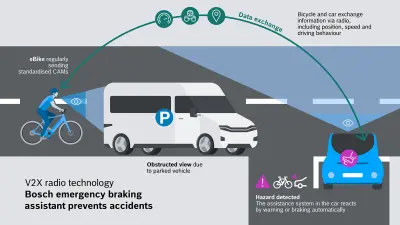V2X technology: How a Bosch automatic emergency braking assist helps prevent collisions
Thanks to V2X technology, vehicles can exchange data directly with their surroundings and with other road users. This enables critical situations to be detected earlier. A project team at Bosch Research demonstrates how this works in practice.

An eBike approaches a junction. A parked van blocks the line of sight — both for the cyclist and for the driver approaching from the other road. They only see each other at the last moment and brake hard. A brief moment of shock, but fortunately nothing bad happened this time. However, in many situations the people involved are no longer able to brake in time, resulting in serious accidents. With today’s increasing traffic density, such dangerous encounters are becoming more frequent. “This makes technologies that help detect critical traffic situations at an early stage all the more important. V2X communication does exactly that: it brings more safety for everyone,” says Frank Hofmann, Chief Expert Connectivity at Bosch Research.
V2X stands for “Vehicle-to-Everything” and refers to a communication system that allows vehicles to exchange information wirelessly. In addition to direct, real-time communication, V2X also includes cloud-based data exchange. Both communication paths together form a hybrid system.

This data exchange is made possible, for example, by so-called Cooperative Awareness Messages (CAM). These are periodically transmitted messages for mutual awareness, which vehicles and other road users send to each other several times per second. The messages follow a harmonised transmission standard and always include up-to-date kinematic data such as position, speed and acceleration values, as well as heading, vehicle type, vehicle dimensions and light status. In this way, a continuous flow of information is created in road traffic, enabling hazardous situations to be detected at an early stage. Connected infrastructure elements — such as traffic lights or mobile construction trailers — likewise transmit their position and situational information, such as signal states or switchovers.
A common language across boundaries
The connected traffic infrastructure with which V2X systems communicate has no central operator — traffic lights, for example, are typically owned by municipalities. Temporary installations such as construction trailers fall under the responsibility of Autobahn GmbH, the German federal highway authority. Other infrastructure elements are managed by regional or national authorities in Germany. To ensure that data exchange works across all these actors nonetheless, V2X relies on harmonised European standards. Message formats and communication channels — such as CAM — are designed so that vehicles and infrastructure elements from different manufacturers and operators interact seamlessly. Only when all vehicles and the infrastructure “speak” the same language can they exchange information with each other.
Vehicles receive these signals and evaluate them in real time using their communication and driver assistance systems. They reconcile them with their own position and compute whether a hazard is imminent. Based on this, assistance systems may react — for example by issuing warnings or initiating automatic braking. The decision always lies with the receiving vehicle. CAMs only provide the relevant information.

Emergency braking assist “sees” round corners
The potential of V2X lies in overcoming visual obstructions. “V2X helps when cameras cannot see — for example round corners or behind a lorry. Through communication, the car can detect what is happening behind a wall and brake in an emergency,” says Florian Wildschütte, Research Engineer in Advanced Digital and AI Solution. The system creates digital models of the surroundings. An algorithm determines whether road users are on a collision course. If required, the system can react on that basis.
The researchers at Bosch Research are extending Bosch’s existing emergency braking assistant system using V2X technology in order to detect critical situations even earlier. As part of the project, a two-stage braking function was developed, controlled by V2X data. To test the new technology, Bosch built a demonstrator vehicle and presented the function to automotive manufacturers.
The emergency braking assist is intended to provide greater safety for crossing vehicles and particularly vulnerable cyclists. According to the German Federal Statistical Office, accident numbers are rising – especially at junctions with limited visibility.
The eBike talks too
The team at Bosch Research plays a leading role in V2X development with the goal of integrating the technology into future assistance systems and increasing traffic safety. While many V2X developments focus on passenger cars, Bosch opted early on to include the eBike as well.
For bicycles, V2X communication works according to the same principle as in cars: a small wireless module with GPS regularly transmits motion data such as position and heading. Unlike in cars, however, the system does not intervene in the braking process automatically. Such automatic interventions are considered too risky on bicycles. Instead, the V2X module continuously transmits positional data to nearby vehicles. Evaluation takes place in the vehicle: the assistance system recognises potential hazards and can automatically brake in the event of an impending collision with an approaching eBike.
“We think holistically — the bicycle is an integral part of traffic and should therefore benefit equally from the safety gains enabled by V2X,” emphasises Christian Cosyns. Since the COVID pandemic, the number of cyclists in EU member states has risen sharply — especially in the eBike segment. In Germany, more than every second newly purchased bicycle is now an eBike. According to the Zweirad-Industrie-Verband (ZIV), the German bicycle industry association, the market share of eBikes in Germany reached 53 percent in 2024. With the increase in cycling, accident rates are also rising — and thus the demand for intelligent safety technologies such as V2X. Bosch strives to make V2X technology available to eBike manufacturers and thereby integrate bicycles as an equal participant in traffic communication.
V2X out on the test track: potential and practice

An analysis of the German In-Depth Accident Study (GIDAS), conducted by Bosch Research together with Bosch Accident Research, shows that the technology can drastically reduce accident risk. “In the course of the project, we analysed 45,000 real accidents with personal injury in Germany in our simulations and found that up to 21,500 of them could have been avoided with a V2X-based braking system,” says Jan Zimmermann, Research Engineer in Advanced Digital and AI Solution.
After the simulation phase, the technology was tested under real conditions: on a test track, a bicycle dummy with GPS and a V2X module was pulled across the road so that it suddenly emerged from a side street, initially outside the driver’s field of vision. The dummy transmitted standardised motion data via radio in real time. The car received the message, detected the impending collision and automatically triggered an emergency braking manoeuvre. Tests were carried out at various speeds: the car was driving at between 20 and 60 km/h depending on the scenario, the bicycle dummy between 15 and 20 km/h. “The car braked in time — the accident could be avoided,” says Jan Zimmermann.
From a small group of communicating vehicles to mass adoption
There is a reason why V2X has not yet been deployed on a broad scale. The system reaches its full potential only when a large proportion of vehicles are equipped with it. “Especially in the initial phase, when market penetration is still low, V2X functions must provide early user benefits. Here, for example, urban infrastructure plays a decisive role: prioritised traffic light switching via V2X — for public transport, emergency vehicles and cyclists — makes the benefits directly tangible and strengthens user acceptance during the introduction phase,” says Christian Cosyns, Senior Product Manager at Bosch eBike Systems.
To integrate bicycles into V2X traffic, incentives are required — either through state regulation or through coordinated industry initiatives, Cosyns explains. “Planning and investment certainty for manufacturers is crucial,” he adds. Bosch eBike Systems is therefore actively involved in the Coalition for Cyclist Safety — a platform uniting leading companies from the telecommunications, automotive, V2X technology and bicycle industry as well as renowned institutes. The goal is to roll out the technology broadly through coordinated market launches, technical synergies and binding collaboration. In parallel with voluntary collaboration in the industry, regulatory processes are also being adapted to technological developments. The European New Car Assessment Programme (NCAP) — decisive for safety ratings of new vehicles — will include V2X functions from 2026 onwards. This creates a strong incentive for manufacturers to integrate the technology.
Today, V2X can already be found wherever infrastructure participates actively in communication — for example at motorway construction sites. Mobile warning trailers from Autobahn GmbH are equipped with V2X modules. When a vehicle approaches, it receives a standardised signal and a construction site warning appears on the vehicle display. To benefit from various V2X functions in the vehicle, it is essential that adoption rates increase. “The more vehicles are equipped with the technology, the greater the safety gains for everyone will be,” says Florian Wildschütte.
Conclusion: connected braking performs better
V2X complements conventional sensor systems wherever they reach their visual limits. With its two-stage braking logic and the exchange of data between cars, eBikes and connected infrastructure elements, the technology elevates road safety to a new level.
-

Florian Wildschütte, Research Engineer in Distributed Systems / Connected Mobility -

Christian Cosyns, Senior Product Manager at Bosch eBike Systems -

Dr Frank Hofmann, Chief Expert Connectivity